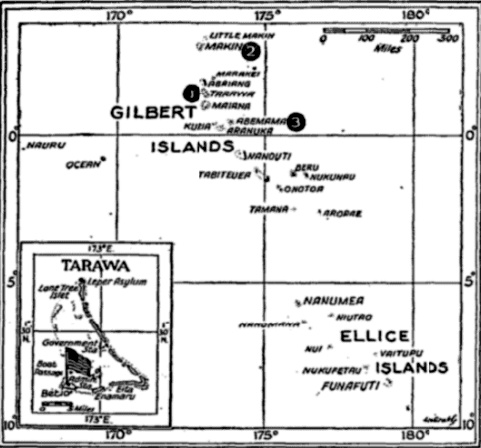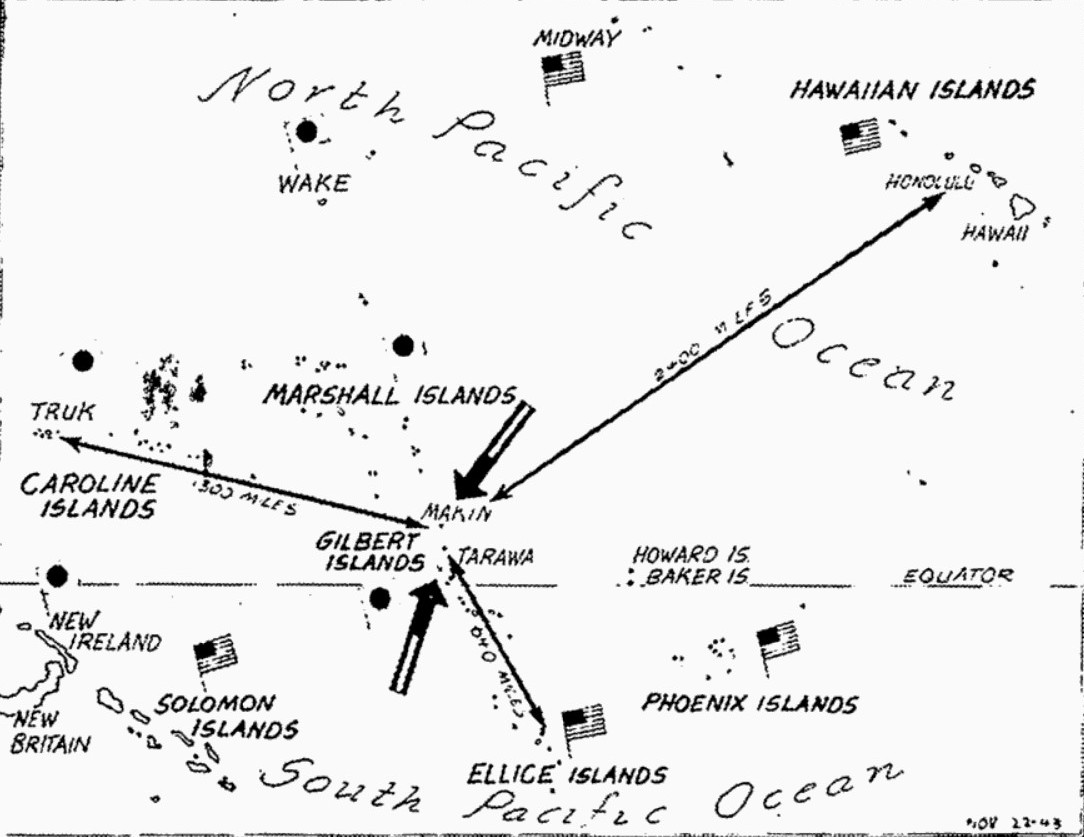The New York Times (November 25, 1943)
Nearly 4,000 Japanese slain on Betio – remnants on the other isles mopped up
By George F. Horne
Gilbert Islands in hands of Americans

In a 76-hour campaign on Tarawa (1), our forces captured Betio Island with its airstrip (inset map) and thus clinched control of the atoll. On Makin (2) and Apamama (3), both now firmly held, enemy remnants were being hunted down.
Foe driven into sea by Marines on Betio
By William L. Worden, for the combined U.S. press
With the 7th Air Force, Central Pacific – (Nov. 22, delayed)
U.S. Marine assault battalions today conquered the western end of Betio Island, on Tarawa Atoll, driving the defenders into the sea and others onto the eastern open flat sections where they became excellent targets for dive-bombing and strafing attacks.
The vicious air attacks were made by Navy planes operating from carriers in this area. The air assault was timed with our artillery fire, which pounded the fleeing Japanese almost at will once they had abandoned their prepared defense positions. Only a few isolated strong Japanese points remain intact.
On the east side of the island, some of the enemy attempted to escape by boat, but our patrol aircraft spotted them, sinking some and damaging others.
Pearl Harbor, Hawaii – (Nov. 24)
The Gilbert Islands have fallen to U.S. forces and resistance has ceased except for the efforts of enemy remnants to prolong final extinction of the last sniper and scattered foxhole inhabitant.
Adm. Chester W. Nimitz, Commander-in-Chief of the Pacific Fleet, announced at 11:30 HT this morning that Betio Island, on Tarawa Atoll, had been captured shortly after noon yesterday following a last-ditch counterthrust that was mercilessly crushed by the 2nd Marines. It was here where the strongest resistance was encountered and here where it might have been expected, for the Betio Atoll had airstrips that we wanted.
Bemused mathematicians were uncertain today as to the time length of the Gilbert Islands occupation. First it was 100 hours, but official rewriting now makes it 76 hours, although lesser statisticians, wandering hereabouts with pencil and paper, figure slightly more. But officially, it is now 76 and corrections to that effect are speeding everywhere.
VAdm. R. A. Spruance, commanding the operation, presented the American people with the Thanksgiving Day gift.
While the capture of these islands may not be of major or defensive character, it has torn down the barrier to what Adm. Nimitz yesterday described as another road to Tokyo. It was a place where the Japanese had put a sign marked “Closed.”
In this short time, we have chocked a big dent in the Japanese perimeter, pushing the line of defense back 192 miles northward to the two islands of Jaluit and Mili, which hang like pendants from the Marshall chains of Ralik and Ratak, known as the Sunset and Sunrise chains, on which our strategic planners may already be gazing.
In connection with the swift wiping-out of the enemy’s garrison in the Gilberts, it is recalled here that Attu in the Aleutians continued organized resistance for more than 70 days. Complete details as to Japanese strength in the Gilberts have not been released, but Betio Island alone in the Tarawa Atoll had approximately 4,000 men. They still had a lot of these up until yesterday, when the hard fighting Marines, including many veterans of Southwest Pacific campaigns, pushed them back to the eastern end of Betio and pinned them there for the final onslaught.
Few Japanese left
There are few of them today, even as prisoners.
Betio fell after troops of the 2nd Marine Division crushed a fierce enemy counterattack. The Marines took very few prisoners. While the communiqué gave the time as shortly after noon, spokesmen here explained that it was at 4:00 p.m. HT and that was only a few minutes after correspondents had filed out of Adm. Nimitz’s room at his headquarters yesterday following a 45-minute interview in which he liberally discussed the Central Pacific offensive and other phases of the war.
His communiqué today said:
Betio Island, Tarawa Atoll, was captured shortly after noon, November 23 (West Longitude Date), following a desperate enemy counterattack which was crushed by troops of the 2nd Marine Division.
Remnants of the enemy are being hunted down on Apamama, Tarawa and Makin Atolls.
Seventh Army Air Force Liberators continued diversionary attacks in the Marshalls.
Adm. Nimitz had said yesterday that the Gilberts were “securely” in our hands, but at the moment the last desperate Japanese forces on Betio were fighting like doomed rats in their corner hedged in by the sea and the coral reefs. A spokesman said today that the counterattackers were “wiped out.”
As to Apamama, it is said there were relatively few Japanese there. This atoll was of less importance than Tarawa and Makin, the former with its airstrips and the latter with three piers and a stone wharf. There were about 1,000 Japanese on Makin and these were presumably also wiped out.
There were virtually no casualties on Apamama among the American invaders.
Makin drive spectacular
The Makin collapse on Monday was preceded by a spectacular enveloping movement at dawn by units of the 26th Division, and this had been preceded by artillery preparation effected by combined infantry and assault forces. The Japanese were in foxholes, pillboxes and crude but strong stockades constructed out of the coconut trees.
The final phases of the capture of the Gilberts are now in progress. Presumably we are now turning attention to the other atoll groups that had been ignored or bypassed and are sweeping clean along the 177-mile-long series of 16 principal atolls, which include many islands and islets.
Navy Seabees and Army engineers have already swarmed ashore in the turbulent wake of the assault forces to prepare bases, installations and positions for further action. Adm. Nimitz made it clear yesterday that we would have airfield facilities not only on Tarawa but on Makin as well.
As for future plans, he has said repeatedly that we will continue to attack, to whittle down the Japanese airpower, already markedly inferior, and to go wherever the Japanese are.
He said yesterday:
The immediate future will be to consolidate and prepare to make further attacks.
We will need more airfields as we move further, and there are plenty of places within the range of our new bases where there are fields in being or where terrain will permit us to build them. Army Liberators of Maj. Gen. Willis H. Hale’s 7th Army Air Force attacked Mili, in the southern Marshalls, on Monday, and pictures are now available showing the effects of even earlier airstrikes on the field there. It is a pretty good field – or, at least, it was.
And there are other important bases and strongholds elsewhere in the Marshalls, including Wotje and Maloelap, both of which are further north than Truk, one of the principal Japanese bases. Wotje and Maloelap are south and a little east of Wake Island. Many students, imagining themselves standing in the newly-won Gilberts, may also look around and see Nauru and Ocean Islands.
Everywhere one looks, there are new prospects, where capable surveyors might lay out yet another “roadwa,” for the vast highway networks, the trunk lines of which must converge on Tokyo.
Our losses high, foe says
Tokyo radio warns Japanese people of bombing attacks
Japanese propagandists gave the figure of 5,000 in estimating casualties of the Americans “during the recent battle” of the Gilbert Islands, and termed the figure “a most disastrous damage for a single engagement of this kind.”
The Tokyo radio, in an English-language broadcast beamed to North America and recorded by U.S. government monitors, rehashed Tuesday’s Japanese Imperial Headquarters communiqué, claiming that one medium-sized aircraft carrier and one destroyer had been sunk, three other carriers, a battleship and a transport heavily damaged and 125 planes shot down “by the war eagle of the Japanese Navy.”
An earlier Tokyo broadcast by Adm. Yoshinari told the Japanese people that “our air strength is what will overwhelm these counterattack attempts of America.”
He said:
Consequently, the people of the home front must not become intoxicated with war victories, but must devote their full efforts in increasing the production of aircraft.
Another Japanese-language broadcast, beamed to South America, said that the Central Pacific was the Japanese Navy’s:
…immovable point and the enemy’s act of advancing is jumping into fire; so, their spirit must be hardened to receiving enormous losses.
A broadcast by Adm. Seizō Kobayashi warned the home front that the Allies had changed their center of operations from the Solomons to the Gilberts and “can be expected to change again,” concentrating on the bombing of Japan proper.


